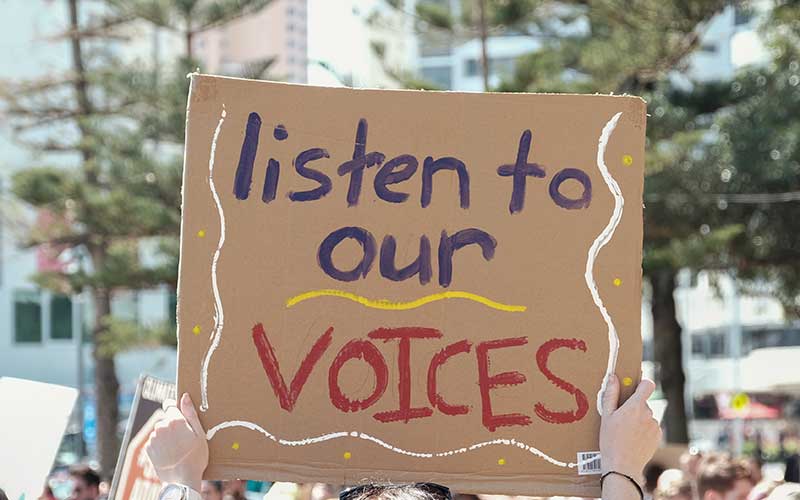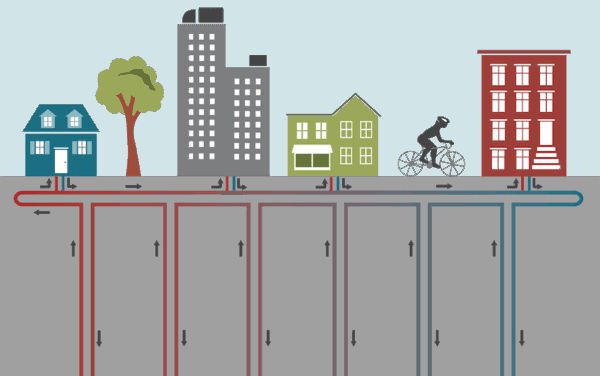
A sign saying "listen to our voices" during a climate protest. Photo: Shutterstock.
If you asked me about tropical storms or hurricanes in Connecticut a few years ago, I would have said we’re lucky enough not to have to worry about them as much as other parts of the country.
But Tropical Storm Henri and the remnants of Hurricane Ida are a vivid reminder that we are contending with a new normal.
Nearly back-to-back, these storms slammed Connecticut – causing flooding and rainfall so severe that Governor Lamont declared a state of emergency. And this makes sense if we look at the latest scientific reports telling us more clearly than ever that climate change is directly connected to such extreme weather (and its increase in frequency). Paired with rising sea levels, a storm doesn’t even have to rate as a Tropical Storm to cause significant damage to our homes and neighborhoods.
That means it’s even more critical for Connecticut to meet the targets in our climate law, the Global Warming Solutions Act, meant to slash the polluting emissions at the root of our crisis. But the state’s latest data show that we’re failing to reduce emissions with the urgency needed to meet those climate targets. So, here’s what we need to do moving forward.
The Current Status Of Polluting Emissions
The Greenhouse Gas Emissions Inventory audits emissions across various sectors – among which transportation, buildings, and electricity are the highest emitters. The most recent report tracks emissions from 2018 (the latest year for which data is available). It shows that Connecticut is not on track to meet our targets of reducing emissions at least 45% below 2001 levels by 2030 and at least 80% by 2050. Worse, the report concludes that Connecticut’s polluting emissions actually increased in 2018. Clearly, the state’s current strategies are not enough to meet our climate goals and need to change.
Connecticut Needs To Act, Now
To dramatically reduce our emissions, Connecticut needs to slash the use of dirty fossil fuels, including gas. The good news is that state officials can act immediately to reduce our state’s reliance on fossil fuels and embrace a clean energy future.
One way is to use the state’s latest energy efficiency plan, which includes programs to make buildings more energy-efficient – like weatherization and financial incentives for energy improvements. To slash emissions, we must expand these programs to make our homes and businesses more energy-efficient. The draft plan as written falls short of what’s needed, but it can still be strengthened. Connecticut’s Department of Energy and Environmental Protection has the authority to approve, reject, or modify the plan, which they will review this fall. The final version of the plan should:
- Eliminate financial incentives for gas appliances like boilers, furnaces, and hot water heaters, which keep us tied down to dirty fossil fuels.
- Expand incentives for clean solutions like electric heat pumps, which are highly energy-efficient and can be used to heat and cool our homes and businesses.
- Include a plan and schedule to fulfill the state’s mandatory goal of weatherizing 80% of homes by 2030 – which would cut down energy demand from household heating and help keep our homes cool in the summer and warm in the winter.
A Future Beyond Gas
Connecticut has done a good job getting rid of coal, but we rely heavily on gas for home heating and electric generation. To meet our climate goals, we must move beyond gas.
As a first step, Connecticut must end its heavily subsidized gas expansion program. This 10-year plan was created in 2013 to expand the state’s gas infrastructure. Gas companies were supposed to meet targets for adding new customers but have failed to meet those targets. Meanwhile, the cost of adding each new customer has doubled and even tripled. State officials are now investigating after finding that gas customers – who have already subsidized the program by over $64 million – are unfairly bearing its risks.
The reality is that gas companies aren’t on our side. Despite its rhetoric, the gas industry does not prioritize the interests of our communities – or a healthy climate. Connecticut should follow other states, like Massachusetts and New York, that are figuring out how to rapidly and equitably phase out gas. Expanding our state’s reliance on gas is the exact opposite of what we should be doing. Connecticut must end this outdated and costly program as soon as possible and develop a plan to move towards clean heating options.
Moving Forward
Calling Henri or Ida our new normal feels scary. But don’t forget that hope exists. We have the solutions to do our part in stopping these climate impacts from getting worse. The Greenhouse Gas Emissions Inventory is a stark reminder that our work isn’t done yet.
It’s time for Connecticut to buckle up and hit the road to reduce emissions and meet our mandatory climate targets for the sake of our residents. Our communities are already suffering from the impacts of climate change, and we can’t accept inaction anymore.



